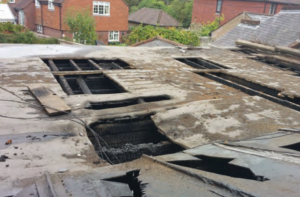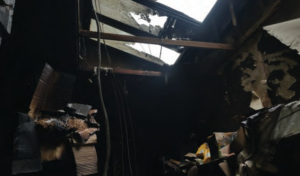Project Objective

Ideal Response were called in to assess the extent of the damage following a fire at a branch of the national supermarket, Co-Op, and to carry out the required cleaning, repairs and restoration in terms of fire and smoke damage.
As licenced waste carriers, we were also requested to dispose of all unsalvageable industrial refrigeration units in accordance with guidelines outlining proper methods for dealing with CFC’s (chlorofluorocarbon or fluorinated greenhouse gas). Fluorinated greenhouse gas, or “F gas”, is found in refrigeration units and should be treated as a hazardous waste material.
The Brief
Our initial assessment found that brickwork, electrical equipment, cabling, furnishings and flooring were all severely damaged. As soot and ash can be extremely acidic and corrosive, it was imperative that we started work as soon as possible to minimise secondary damage.
As part of preparing the area for remedial works, we allowed for scaffolding and provided a generator for power and temporary lighting to enable work to progress as quickly and safely as possible.
Speak to our restoration experts now
01622 926 505The extent of the works meant that we would be working in partnership with other service providers, as part of a collaborative approach. This meant the least disruption to the client as work would be completed in the minimal timeframe possible.
The Technical Part

A full risk assessment was carried out then safety precautions put in place to allow safe access to the store room area for the staff.
When thinking of smoke and fire damage, people often forget the water damage caused by the fire fighting attempts. So, before the remedial work could begin, we first had to ensure that the building and affected areas were dry.
To enable this, services were disconnected and our desiccant dehumidifiers were installed to ensure the building was adequately dry in preparation for remediation. Our decision to use desiccant dehumidifiers was due to the cold weather -desiccants are more effective at lower temperatures.
Our desiccants also come with advanced remote monitoring equipment which enabled our technical team to monitor moisture levels, the amount of water vapour removed, and equipment health, all in real-time.

Structural work began at the outset. A lean-to outbuilding was removed and a breeze block CCTV room was also dismantled and removed. The existing checker plate floor covering needed to be lifted and partition walls knocked down. The structure needed to be cut back to the party wall to allow fire-damaged timber to be replaced. All fire-damaged walls were stripped back to bare brick in preparation for our fire damage cleaning services.
The fire cleaning method used on this project was Soda Blasting. Soda Blasting removes smoke stains, soot and char quickly and efficiently while acting as a mild deodorizer. This process works by using compressed air coupled with sodium bicarbonate at a relatively low pressure of around 20psi to apply mild abrasive force to affected surfaces. This method brings buildings back to their original state, leaving little to zero trace of a fire.
After completing the Soda Blast treatment, we applied our solvent-free, water-based bonding agent to affected porous surfaces. This creates a permanent, sealed barrier locking in any remaining smoke odour particulates.
The Results
The scheduled work was to be completed within a three week period and Ideal Response provided continuous support to ensure that deadlines were met.
Our clients were pleased with the service they received and our ability to overcome difficulties quickly, commenting:
“All work carried out to a good standard. Although the team encountered some problems with their equipment, they resolved issues effectively. Overall, very happy with the operatives and the job.”
The Technology & Equipment
There is much to consider when drying a building and numerous variables can affect the efficiency. So how do we keep on top of the drying process to ensure the most efficient method, in terms of time, cost and energy consumption for our clients?
Using Corroventa’s SuperVision®, we are able to remotely control, monitor and measure the drying process, wherever we are. With complete control without having to be onsite means that we can make the necessary adjustments at any time of day, at no extra cost to our clients. Not only does remote monitoring mean that we can reduce energy consumption, it also means that we can finish the drying process at precisely the right time. With charts, graphs and in-depth insight, we are able to guarantee the correct conditions for the most effective and efficient drying.
It also allows us to provide custom reports which our clients may need for insurance purposes. With remote monitoring, we will be aware as to when the drying process is complete without having to make periodic site visits to check progress. This means that we can arrange the next stage of the fire damage restoration much sooner, minimising disruption – and costs – to our clients even further.



